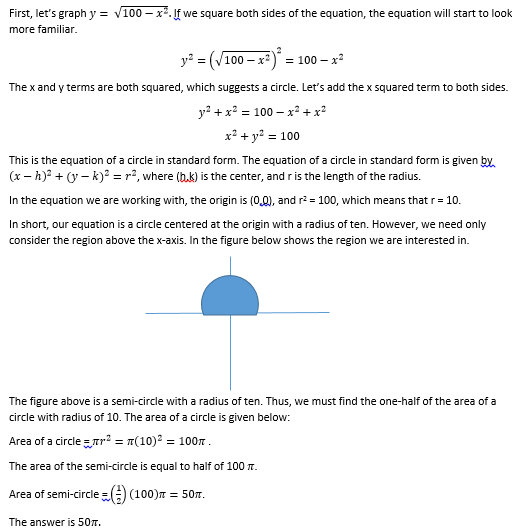How to find the area of a circle
Help Questions
Geometry › How to find the area of a circle
100_π_
50_π_
25_π_
10_π_
20_π_
Explanation
If the diameter of the circle below is 

Explanation

From the given figure, you should notice that the base of the triangle is the same as the diameter of the circle.
In order to find the area of the shaded region, we will first need to find the area of the circle and the area of the triangle.
Recall how to find the area of a circle:
Now recall the relationship between the radius and the diameter.
Plug in the value of the diameter to find the value of the radius.
Now, plug in the value of the radius in to find the area of the circle.
Next, recall how to find the area of a triangle.
The height is already given by the question, and remember that the base is the same as the diameter of the circle.
Plug in these values to find the area of the triangle.
We are now ready to find the area of the shaded region.
Remember to round to 
A square with a side length of 4 inches is inscribed in a circle, as shown below. What is the area of the unshaded region inside of the circle, in square inches?

8π - 16
4π-4
8π-4
2π-4
8π-8
Explanation
Using the Pythagorean Theorem, the diameter of the circle (also the diagonal of the square) can be found to be 4√2. Thus, the radius of the circle is half of the diameter, or 2√2. The area of the circle is then π(2√2)2, which equals 8π. Next, the area of the square must be subtracted from the entire circle, yielding an area of 8π-16 square inches.
Find the area of a circle that has a radius of 
Explanation
Use the following formula to find the area of a circle:
For the circle in question, plug in the given radius to find the area.
We know the radius is 

Recall that when a square root is squared you are left with the number under the square root sign. This happens because when you square a number you are multiplying it by itself. In our case this is,

From here we can use the property of multiplication and radicals to rewrite our expression as follows,
and when there are two numbers that are the same under a square root sign you bring out one and the other number and square root sign go away.
If a rectangle with a diagonal of 
Explanation

Notice that the diagonal of the rectangle is the same as the diameter of the circle.
Now, recall the relationship between the diameter of a circle and its radius:
Substitute in the given diameter to find the radius of the circle.
Simplify.
Finally, recall how to find the area of a circle:
Substitute in the value of the radius to find the area.
Solve.
A circle has a radius of 
Explanation
The formula for the area of a circle is:
The radius of the circle is 
So the area of the circle is 
If the diameter of the circle below is 

Explanation

From the given figure, you should notice that the base of the triangle is the same as the diameter of the circle.
In order to find the area of the shaded region, we will first need to find the area of the circle and the area of the triangle.
Recall how to find the area of a circle:
Now recall the relationship between the radius and the diameter.
Plug in the value of the diameter to find the value of the radius.
Now, plug in the value of the radius in to find the area of the circle.
Next, recall how to find the area of a triangle.
The height is already given by the question, and remember that the base is the same as the diameter of the circle.
Plug in these values to find the area of the triangle.
We are now ready to find the area of the shaded region.
Remember to round to 
If a rectangle with a diagonal of 
Explanation

Notice that the diagonal of the rectangle is the same as the diameter of the circle.
Now, recall the relationship between the diameter of a circle and its radius:
Substitute in the given diameter to find the radius of the circle.
Simplify.
Finally, recall how to find the area of a circle:
Substitute in the value of the radius to find the area.
Solve.
Find the area of the circle with the given diameter.

Explanation
Recall how to find the area of a circle.
Now, since we have the diameter, recall the relationship between the radius and the diameter.
Substitute in the value of the diameter to find the value of the radius.
Simplify.
Substitute in the value of the radius to find the area.
Solve.
A circle is inscribed in a square that has side lengths of 
Explanation

Notice that when a circle is inscribed in a square, the length of the side of the square is the same as the diameter of a circle.
Recall how to find the area of a circle:
Now, recall the relationship between the radius and the diameter.
Use the given information to find the radius.
Simplify.
Now, substitute in the value of the radius to find the area of the circle.
Solve.


















































































